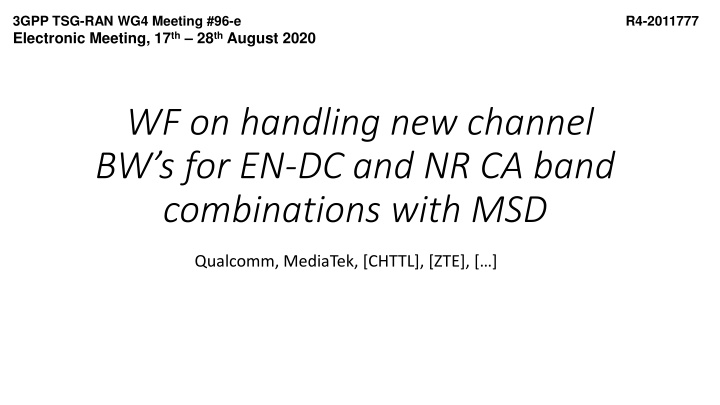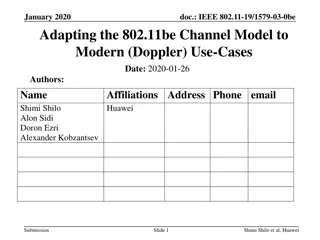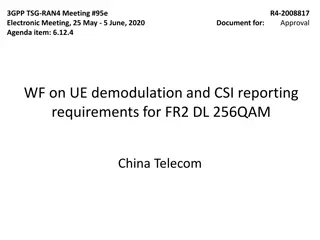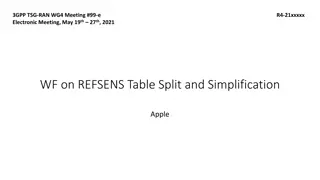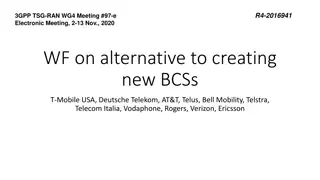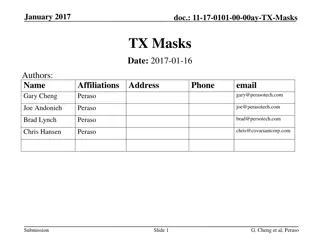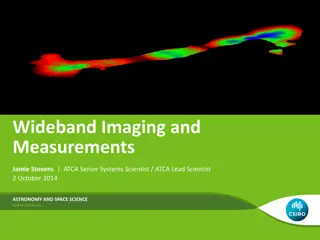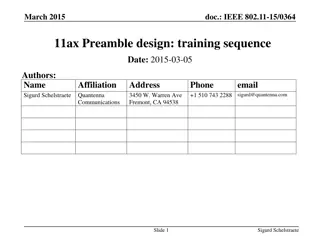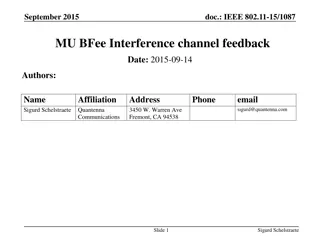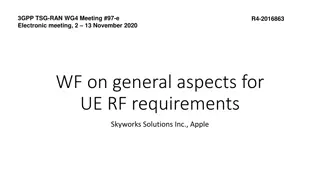Impact of New Channel Bandwidths on EN-DC and NR CA Requirements
In the electronic meeting of 3GPP TSG-RAN WG4, the addition of new channel bandwidths to various NR bands raises concerns for EN-DC and NR CA requirements. Higher bandwidths can affect end-to-end connectivity as highlighted in examples. MSD values for different band combinations were derived and discussed. The impact of larger bandwidths on UL configuration and TX distortion was emphasized. The meeting highlighted challenges in ensuring compatibility between different channel bandwidths and transmission configurations, particularly affecting bands like n1, n40, n3, and others.
Download Presentation

Please find below an Image/Link to download the presentation.
The content on the website is provided AS IS for your information and personal use only. It may not be sold, licensed, or shared on other websites without obtaining consent from the author.If you encounter any issues during the download, it is possible that the publisher has removed the file from their server.
You are allowed to download the files provided on this website for personal or commercial use, subject to the condition that they are used lawfully. All files are the property of their respective owners.
The content on the website is provided AS IS for your information and personal use only. It may not be sold, licensed, or shared on other websites without obtaining consent from the author.
E N D
Presentation Transcript
3GPP TSG-RAN WG4 Meeting #96-e Electronic Meeting, 17th 28th August 2020 R4-2011777 WF on handling new channel BW s for EN-DC and NR CA band combinations with MSD Qualcomm, MediaTek, [CHTTL], [ZTE], [ ]
Background (1/2) In TS38.101-1, new channel BWs were and continue to be added to various NR bands that could impact ENDC and NRCA requirements 25M, 30M, 40M, 50M was added to n1 in release 16 20M was added to n5 in release 16 Impact of higher BWs already present in release 15, but not vetted correctly such as n40. 35MHz for NR band n3, n7, n8, n25, n66, n71 45MHz for NR band n3, n25, n66. 90M, 100M BWs to be added for n40. Stand alone REFSENS and AMPR requirements were derived and agreed for new Channel BWs in TS38.101-1. However, new channel BWs can impact ENDC in TS38101-1 and NRCA REFSENS in TS38.101-1 due to TX distortion, even if UL configuration is restricted as described in detail in [1] Impacted Examples of ENDC combinations are DC_3_n1, DC_1_n40, DC_28_n5
Background (2/2) MSD values were derived highlighted below as follows for DC_1_n40 [2] and DC_3_n1 [3] using the conditions for UL configuration as described in Notes 1-3 in Table 7.3B.2.3.4-2 of TS38.101-3. CIM3, CIM5 and Image become a factor for large BWs since the separation between the UL allocation and TXLO increases. So, using the conditions of notes 1-3 will result in considerably large MSD values as highlighted below. It was mentioned that Tables can get messy and confusing with the added notes NOTE 1: The UL configuration applies regardless of the channel bandwidth of the UL band. UL resource blocks allocation in the table shall be further limited to that specified in Table 7.3.1-2 in TS 36.101 [4] or Table 7.3.2-3 in TS 38.101-1 [2]. NOTE 2: The UL resource blocks shall be located as close as possible to the downlink operating band but confined within the transmission bandwidth configuration for the channel bandwidth. NOTE 3: When the maximum UL RB allocation LCRB value is less than the maximum transmission bandwidth configuration NRB defined in Table 5.3.2-1 in 38.101-1 [2] for the specified UL band SCS, the UL band should be configured using the lowest CBW that is compatible with the maximum specified LCRB value. E-UTRA or NR Band / SCS / Channel bandwidth of the affected DL band / UL RB allocation of the agressor band UL band band of UL band (kHz) n403 1 30 NOTE 3: Applicable only for n40 UL BW = 80MHz. E-UTRA or NR Band / Channel bandwidth of the affected DL band / MSD 15 MHz (dB) (dB) (dB) (dB) 8.3 8.3 [21.5] [21.5] NOTE 3: Applicable only for n40 UL BW = 80MHz. UL band DL band 5 MHz (dB) 10 MHz (dB) 8.3 [21.5] 20 MHz 25 MHz 30 MHz 40 MHz (dB) 50 MHz (dB) 60 MHz (dB) 80 MHz (dB) 90 MHz (dB) 100 MHz (dB) DL SCS 5 MHz (LCRB) 10 MHz (LCRB) 15 MHz (LCRB) 20 MHz (LCRB) n40 n40 1 13 8.3 [21.5] [50] [50] [50] E-UTRA or NR Band / Channel bandwidth of the affected DL band / MSD 10 MHz (dB) (dB) (dB) (dB) 2.3 2 1.8 [4.1] [3.9] [3.8] []16.0 [14.3] [13.2] NOTE 3: These requirements apply when the uplink is active in Band n1, n84 and the separation between the lower edge of the uplink channel in Band n1, n84 and the upper edge of the downlink channel in Band 3 is < 60 MHz. For each channel bandwidth ( 20MHz) in Band 3, the requirement applies regardless of channel bandwidth in Band n1, n84. NOTE 5: Applicable only for n1 UL BW = 25, 30, 40MHz. NOTE 6: Applicable only for n1 UL BW = 50MHz. UL band DL band 5 MHz (dB) 15 MHz 20 MHz 25 MHz 30 MHz (dB) 40 MHz (dB) 50 MHz (dB) 60 MHz (dB) 80 MHz (dB) 90 MHz (dB) 100 MHz (dB) n13 n13,5 n13,6 3 3 3 3.0 [4.5] [16.9]
WF Consider options on how to handle the larger BWs: Option 1: Consider limited ULBWs for ENDC combinations when specifying cross band noise MSD. Currently all BWs in each RAT are fair game. Possibly introducing a separate table in 38.101-3 for supported ULBWs for ENDC and NRCA combinations. Operator still may deploy the larger BW, but UE should not be forced to meet the ENDC/RCA REFSENS requirement Option 2: Consider adjusting the UL allocation location in the channel BW to avoid TX image, CIM3 and CIM5. and support all ULBWs in the List the ULBW and the corresponding UL configuration (allocation and location) for MSD no larger than the existing MSD Introduce a separate table that has an UL allocation and location specific to the ENDC combination Option 3: Other options not precluded. Companies are encouraged to investigate and propose best solution by introducing CR in RAN4#97-e.
References 1. R4-2009628, ENDC crossband noise impact with large NR BW , RAN4#96-e, Qualcomm Inc. August 2020 2. R4-2009623, CR for missing DC_1A_n40A Cross Band Noise MSD for large NR UL BW in 38.101-3 , RAN4#96-e, Qualcomm, August 2020. 3. R4-2009620, CR for missing DC_3A_n1A Cross Band Noise MSD for large NR UL BW in 38.101-3 , RAN4#96-e, Qualcomm, August 2020.
